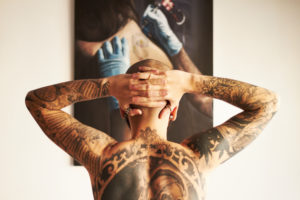
Person with tattoos with hands on their head.
This article was originally published on Wear Your Voice Magazine and republished here with the author’s permission.
You’ve taken the time, done your research, and decided on your tattoo. You’ve saved up money and investigated tattoo shops for the perfect artist to mark your design. You’re excited, nervous, and eager to get started.
But the tattooer takes one look at you and says, “Your skin tone is a problem.” Never mind that you’ve seen tattoos on dark skin — and with color no less. Hell, your brown or Black self has beautiful color tattoos which have stood the test of time.
Yet here is this artist you respected, admired, and sought out to give them a lot of money to tattoo you, and they’re looking at you like you dragged dog shit into the place. Suddenly you feel sick to your stomach — and not from tattoo nerves. You’ve just been skin-shamed.
As a heavily tattooed biracial Sri Lankan American woman, this scenario has played out for me again and again, in context of almost every single tattoo artist with whom I’ve ever consulted. Worse, even brown tattooers who are covered head to foot in designs have frowned at my skin and played that I’m going to be really difficult to tattoo.
I’ve had to put my foot down, explain how my particular melanin works and what colors will stick, and hope for the best. Or walk out and start researching artists from scratch.
These days you don’t even have to be a brown or Black person and go into a tattoo parlor to experience skin-shaming: racism and colorism happen often on tattoo reality shows and competitions aired weekly.
Most recently, on Spike’s ninth season of Ink Master, there were only five “human canvases” with darker skin, and four of them were openly skin shamed with comments like:
“That’s the one I wanted the least. How are you at tattooing really dark skin like that?” –Doom Kitten said in (Ep 6).
“This girl has dark skin and she wants tons of information put into this thing.”
—Tommy Helm, Empire State Studios (Ep 9).
“It’s [a] weird [idea] and the skin tone issue.”
—Matt O’Baugh, Black Cobra Tattoos ( Ep 10), about a Black couple who were getting tattooed together.
While these are only a few examples from the current season of Ink Master, I have seen far more skin-shaming going on in previous seasons. And what’s worse is when a brown or Black tattooer looks down their nose at tattooing a fellow dark-skinned person.
This false and pervasive narrative of the ideal skin color to tattoo as being white is so ingrained in the tattoo community and industry at large, even tattooers of color buy into it.
But here is the historically and socio-culturally painful irony of these examples of blasé colorism in the tattoo industry: Tattoos were invented by brown and Black people centuries — even millennia — before white supremacy became the dominant global paradigm.
All of these skin-shaming tattooers seem to have forgotten that the modern tattooing practice was culturally appropriated by white colonizers from indigenous spiritual, sacred, and cultural practices around the world and co-opted into the capitalist venture we find today.
From India, China, Japan, New Zealand, the Philippines, Nepal, the Andean region, Mongolia, Egypt, Samoa, Indonesia, Thailand, the Sudan, Morocco, Ethiopia, Burma, and even the Middle East — all brown and Black people — the history of tattooing is rich and deep.
It is from these originators of art in the skin that white people discovered the practice and began erasing it from its often-spiritual roots in each respective society. Even in Sri Lanka there is an indigenous tribe with its own hand-poked tattoo method that has persisted to this day.
And much like other culturally appropriated often-spiritual practices that have been transformed into capitalist consumption enterprises (yoga), the modern tattooing industry often marginalizes the very people it has stolen these practices from.
You will tattoo an om or Ganesh on a white chick, but not the Desi Hindu from whose heritage the symbols originates because of “skin tone issues”?
The one tattooer who did not skin shame me had, incidentally, completed her apprenticeship training in New Zealand with a Māori tattoo artist. She was the one who taught me that my particular blend of melanin works better with cool colors like blues, purples, and greens.
She had no compunction against tattooing me with bold colors, and in fact loved my clear skin. For her, problematic skin had lots of freckles and moles since tattooing over and through these can increase a person’s likelihood of skin cancer.
Perpetuating this notion that darker-toned skin is harder to tattoo needs to stop, and a good way is for this racist narrative to be eliminated from tattoo shows on television across the board. When a tattooer starts whingeing about “skin tone issues” that entire dialogue needs to be shut down immediately.
It’s not bad enough that the tattoo industry is itself an enormous money-making enterprise in cultural appropriation, it also continues to tattoo the so-called ideal fair skin with the cultural, social, and historical markers of the brown and Black people from whom these practices have been appropriated while marginalizing POC from its practice altogether.
[do_widget id=’text-101′]
Sezin Koehler is a biracial Sri Lankan American novelist and blogger whose writings have been featured on Wear Your Voice Magazine, Bitch, Broadly, The Mary Sue, Ravishly, Huffington Post, Sociological Images, and the popular Twin Peaks fansite 25 Years Later. An adult Third Culture Kid, Sezín has lived in 13 countries and 18 cities around the world, and now calls Lighthouse Point, Florida home. You can find her Tweeting about politics, Facebooking about writing and culture, and Instagramming her growing collection of art and tattoos.
Search our 3000+ articles!
Read our articles about:
Our online racial justice training
Used by hundreds of universities, non-profits, and businesses.
Click to learn more




















